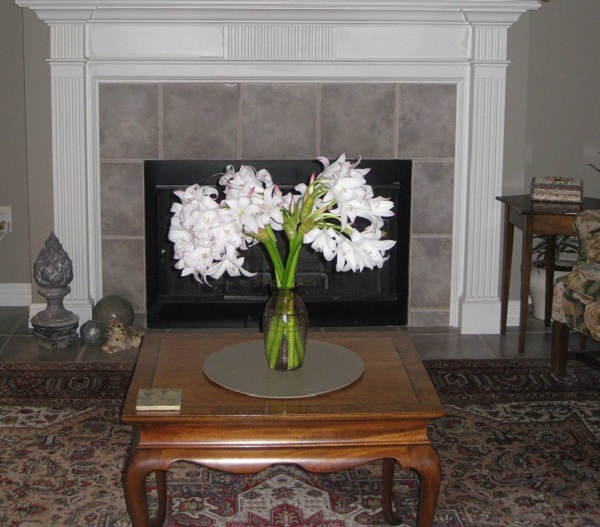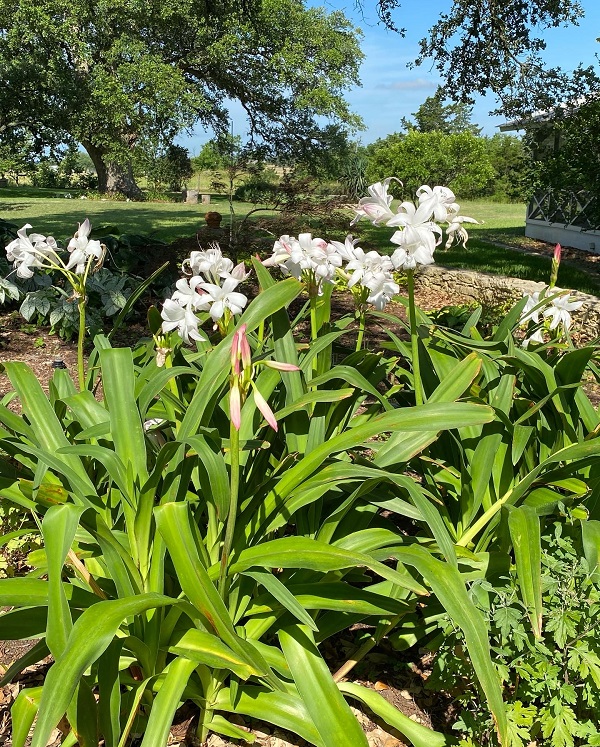


When I am trying to decide what bulb to give as a gift to friends and family, this is the first bulb I think of! I love the texted photos that come in randomly as we reconnect with old friends.
The Name: Crinum 'Mrs. James Hendry' is one of our favorite crinums. I've tried calling it MJH or just Hendry (with a hard "d"), but for some reason I continue to call her by the full name 'Mrs. James Hendry', even in casual conversation. This flower deserves a glorious title that matches the quality of the flower bulb, but who in the world was 'Mrs. James Hendry?' I don't know the answer, but she must have been remarkable. We do know, according to Scott Ogden in his great book "Garden Bulbs for the South" that "Henry Nehrling [a Florida nurseryman] introduced another handsome blush-colored hybrid around 1915. This exquisite flower, 'Mrs. James Hendry', ranks among the most beautiful and rewarding Southern perennials."

Fragrance: This crinum fills my personal garden for many reasons, and fragrance is one of them. 'Mrs. James Hendry' is a fine selection of crinum with flowers that open up wide for the whole world to see, and release a delightful smell at the same time. The stems are begging to be cut and brought inside from the heat (even though ours continues to bloom in 100 degree heat outside). Cut a flower stalk from this large bulb and place it in your bedroom overnight. A light spicy fragrance will fill the room and grace your dreams.

Bloom Time: Starting in late May, this crinum blooms heavily through early summer and then intermittently throughout the rest of the summer. Multiple blush flowers appear on several stalks that shoot up, one after another, giving a jaw dropping display of color and style to your garden. In the fall, when temperatures drop, mature clumps continue to provide blooms, and if no freezes or hard frosts occur, we generally have blooms for Thanksgiving! If you live closer to the Gulf Coast or Atlantic Ocean (Houston, Mobile, New Orleans, Savannah, Charleston, etc), or in warmer climates like Southern California or Arizona, the Crinum ‘Mrs. James Hendry' will bloom almost all year long in the absence of a hard freeze.

Dormancy: When the freeze or hard frost does come in late fall or early winter, let the foliage die down naturally. It will quickly turn brown and drape over the clump of bulbs like a blanket protecting it from colder winters. You can remove the foliage, but if you do, consider mulching the clump if you are in Zone 8 or colder Plant bulbs like Narcissus 'Grand Primo' and "Campernelles" around the outer circle of the clump of bulbs to bring a seasonal change of color for winter and spring while the crinums lay dormant.

Companion Plants: Great companion plants include lantana, phlox, and salvias around outer base of the bulbs. Also, consider planting the bulbs behind low trimmed hedges or behind benches, as they will grow and bloom about 4 to 5' high and show themselves just fine, while the base remains hidden behind these other structures.
Large bulbs are 1) quicker in their life to dividing and producing more offsets (babies) and 2) have a higher likelihood of larger and more blooms the first year.
Plant now in good garden soil with plenty of sun. Water regularly during the hot dry months of summer. They will bulk up and multiply quickly!

When I am trying to decide what bulb to give as a gift to friends and family, this is the first bulb I think of! I love the texted photos that come in randomly as we reconnect with old friends.
The Name: Crinum 'Mrs. James Hendry' is one of our favorite crinums. I've tried calling it MJH or just Hendry (with a hard "d"), but for some reason I continue to call her by the full name 'Mrs. James Hendry', even in casual conversation. This flower deserves a glorious title that matches the quality of the flower bulb, but who in the world was 'Mrs. James Hendry?' I don't know the answer, but she must have been remarkable. We do know, according to Scott Ogden in his great book "Garden Bulbs for the South" that "Henry Nehrling [a Florida nurseryman] introduced another handsome blush-colored hybrid around 1915. This exquisite flower, 'Mrs. James Hendry', ranks among the most beautiful and rewarding Southern perennials."

Fragrance: This crinum fills my personal garden for many reasons, and fragrance is one of them. 'Mrs. James Hendry' is a fine selection of crinum with flowers that open up wide for the whole world to see, and release a delightful smell at the same time. The stems are begging to be cut and brought inside from the heat (even though ours continues to bloom in 100 degree heat outside). Cut a flower stalk from this large bulb and place it in your bedroom overnight. A light spicy fragrance will fill the room and grace your dreams.

Bloom Time: Starting in late May, this crinum blooms heavily through early summer and then intermittently throughout the rest of the summer. Multiple blush flowers appear on several stalks that shoot up, one after another, giving a jaw dropping display of color and style to your garden. In the fall, when temperatures drop, mature clumps continue to provide blooms, and if no freezes or hard frosts occur, we generally have blooms for Thanksgiving! If you live closer to the Gulf Coast or Atlantic Ocean (Houston, Mobile, New Orleans, Savannah, Charleston, etc), or in warmer climates like Southern California or Arizona, the Crinum ‘Mrs. James Hendry' will bloom almost all year long in the absence of a hard freeze.

Dormancy: When the freeze or hard frost does come in late fall or early winter, let the foliage die down naturally. It will quickly turn brown and drape over the clump of bulbs like a blanket protecting it from colder winters. You can remove the foliage, but if you do, consider mulching the clump if you are in Zone 8 or colder Plant bulbs like Narcissus 'Grand Primo' and "Campernelles" around the outer circle of the clump of bulbs to bring a seasonal change of color for winter and spring while the crinums lay dormant.

Companion Plants: Great companion plants include lantana, phlox, and salvias around outer base of the bulbs. Also, consider planting the bulbs behind low trimmed hedges or behind benches, as they will grow and bloom about 4 to 5' high and show themselves just fine, while the base remains hidden behind these other structures.
Large bulbs are 1) quicker in their life to dividing and producing more offsets (babies) and 2) have a higher likelihood of larger and more blooms the first year.
Plant now in good garden soil with plenty of sun. Water regularly during the hot dry months of summer. They will bulk up and multiply quickly!